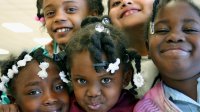Social and Emotional Learning Research Review: Evidence-Based Programs
Choosing the best program to implement social and emotional learning in your school can be daunting. Edutopia’s research analyst recommends these research-proven programs.
Given the strong evidence that social and emotional learning can contribute to academic success, how do educators choose the right SEL programs? See below for our recommendations for some of the most effective research-proven SEL programs available.
____________________________________________________________________________________________
Roots of Empathy: K-8
Practices
- Classroom sessions over a twenty-seven-week program involve nine family visits with a baby (ages 6-12 months). The trainer facilitates the curriculum, and can be anyone except the teacher who participates in a training program with Roots of Empathy.
Outcomes & Evidence
- Decreased aggression (approximately half as many youth getting into fights each year)
- Increased prosocial behavior
- Immediate and long-term effects, lasting up to three years after intervention
____________________________________________________________________________________________
Positive Action: K-12
Practices
- Thinking and doing positive actions
- Based on the premise that you feel good about yourself when you think and do positive actions, and that there is always a positive way to do things.
Outcomes & Evidence
- Academic achievement gains, averaging 14 percentile points
- Decreased violent behaviors, averaging 19 percentile points
____________________________________________________________________________________________
Practices
- Morning meetings
- Three to five positively stated school rules (developmentally and individually relevant to the child) for the whole school or classroom
- Responding to misbehavior with positive redirecting language and logical consequences
- Problem-solving strategies in class or small-groups; written agreements with individual students
- Modeling, role-playing and positive teacher language to teach expected behaviors
- Continuous evaluation of implementation and impact
Outcomes & Evidence
- Increased math and reading test scores
- Improved student attitudes about schools, teachers, and peers
- Decreased misbehavior and improved social skills
- Teachers felt more effective and positive about teaching, offered higher-quality instruction, and collaborated more frequently with other teachers
____________________________________________________________________________________________
Second Step: Pre-K-8
Practices
- Skills in impulse control, (e.g. using self-talk), showing empathy, anger and emotional management, and problem-solving
- Brain Builder Games to develop self-regulation skills
Outcomes & Evidence
- Increased cooperative behavior
- Reduced aggression in the classroom, lasting up to six months.
____________________________________________________________________________________________
Meditation: K-12
Practices
- Mindfulness, or open-monitoring meditation, involves observing thoughts and emotions without reacting to them.
- Focused-attention meditation involves focusing on a single object.
- School-based meditation practices ranged from 10 to 40 minutes, daily to bi-weekly, over three to six months.
Outcomes & Evidence
- Decreased aggression and rule infractions
- Improved academic functioning on attention-skills tests
- Decreased anxiety
____________________________________________________________________________________________
Service Learning: K-12
Practices
- Involving students in designing, implementing, and evaluating service projects
- Community partnerships that provide real-world context for service, communication, and interaction
- Projects have clear educational goals and meet genuine community needs
Outcomes & Evidence
- Can protect from negative life stresses
- Can improve relationships with peers and adults
- Can increase civic engagement
(Hamilton & Fenzel, 1988; Yates & Youniss, 1996; Markus et al, 1993; cited in Stukas, Clary & Snyder, 1999; Scales et al., 2000; Billig, 2002)
____________________________________________________________________________________________
Schoolwide Positive Behavior Support: K-5
Practices
- Schoolwide Positive Behavior Support (SWPBS), also known as Positive Behavioral Interventions and Supports (PBIS or PBS), is an approach to preventing problem behaviors and promoting positive behaviors.
- Three to five positive expectations are chosen and reinforced for the entire school.
Outcomes & Evidence
- Moderately effective in reducing misbehavior, particularly in urban settings
____________________________________________________________________________________________
Practices
- RULER emphasizes systematic professional development for educators (school leaders, teachers, support staff) and families so that emotions become central to learning, teaching, and parenting.
- Educators work directly with researchers and trainers at the Yale Center for Emotional Intelligence, and then devise a plan for rolling out the RULER approach with their faculty/staff, students, and families.
Outcomes & Evidence
- Improved academic performance, increased positive social behavior, improved academic behaviors, and improved climate at the school
____________________________________________________________________________________________
(*) Programs and practices listed here received support from at least three studies by independent evaluators and/or peer-reviewed publications, using controlled experimental designs and independent outcome measures. Please leave a comment to alert us to additional programs that have strong evidence of success.
Continue to the next section of the SEL research review, Avoiding Pitfalls.
SEL Research Table of Contents:
- Introduction and Learning Outcomes
- Evidence-Based Programs
- Avoiding Pitfalls
- Annotated Bibliography
